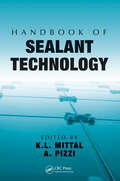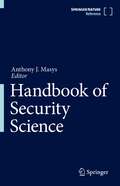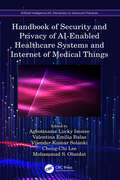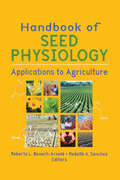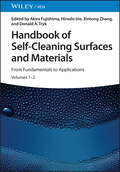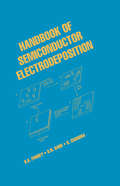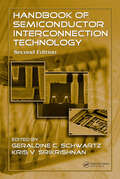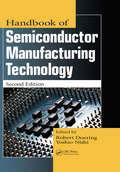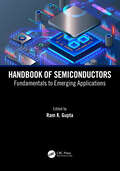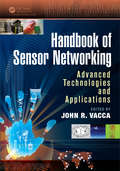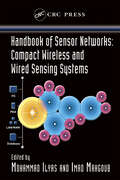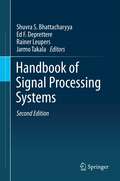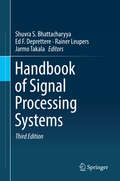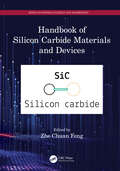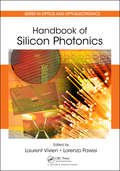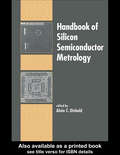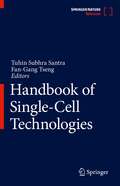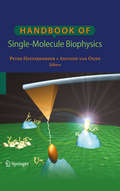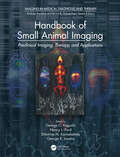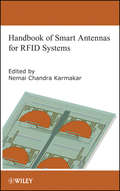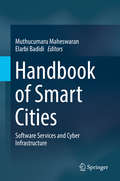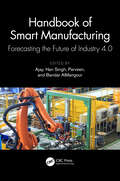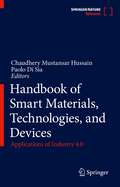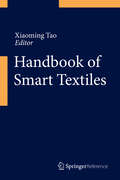- Table View
- List View
Handbook of Sealant Technology
by K. L. Mittal A. PizziSealing is an age-old problem that dates back to our earliest attempts to create a more comfortable living environment. Prehistoric people used natural sealants such as earth, loam, grass, and reeds to protect the interior of their homes against the weather. Today's applications extend to a myriad of uses. The Handbook of Sealant Technology provide
Handbook of Security Science
by Anthony J. MasysThis handbook offers insights into how science (physical, natural and social) and technology can support new developments to manage the complexity resident within the threat and risk landscape.The security landscape can be described as dynamic and complex stemming from the emerging threats and risks that are both persistent and transborder. Globalization, climate change, terrorism, transnational crime can have significant societal impact and forces one to re-evaluate what ‘national security’ means. Recent global events such as mass migration, terrorist acts, pandemics and cyber threats highlight the inherent vulnerabilities in our current security posture. As an interdisciplinary body of work, the Handbook of Security Science captures concepts, theories and security science applications, thereby providing a survey of current and emerging trends in security. Through an evidence-based approach, the collection of chapters in the book delivers insightful and comprehensive articulation of the problem and solution space associated with the complex security landscape. In so doing the Handbook of Security Science introduces scientific tools and methodologies to inform security management, risk and resilience decision support systems; insights supporting design of security solutions; approaches to threat, risk and vulnerability analysis; articulation of advanced cyber security solutions; and current developments with respect to integrated computational and analytical solutions that increase our understanding of security physical, social, economic, and technological interrelationships and problem space.
Handbook of Security and Privacy of AI-Enabled Healthcare Systems and Internet of Medical Things (ISSN)
by Mohammad S. Obaidat Valentina Emilia Balas Vijender Kumar Solanki Agbotiname Lucky Imoize Cheng-Chi LeeThe fast-growing number of patients suffering from various ailments has overstretched the carrying capacity of traditional healthcare systems. This handbook addresses the increased need to tackle security issues and preserve patients’ privacy concerns in Artificial Intelligence of Medical Things (AIoMT) devices and systems.Handbook of Security and Privacy of AI-Enabled Healthcare Systems and the Internet of Medical Things provides new insights into the deployment, application, management, and benefits of AIoMT by examining real-world scenarios. The handbook takes a critical look at existing security designs and offers solutions to revamp traditional security architecture, including the new design of effi cient intrusion detection algorithms, attack prevention techniques, and both cryptographic and noncryptographic solutions. The handbook goes on to discuss the critical security and privacy issues that affect all parties in the healthcare ecosystem and provides practical AI-based solutions.This handbook offers new and valuable information that will be highly beneficial to educators, researchers, and others.
Handbook of Seed Physiology: Applications to Agriculture
by Rodolfo A. Sánchez Roberto L. Benech-ArnoldThe latest findings in seed physiologydiscussed as they relate to agricultural problems! Presenting the latest findings in the area of seed physiology as well as the practical applications of that knowledge in the field, the Handbook of Seed Physiology: Applications to Agriculture provides a comprehensive view of seed biology and it
Handbook of Self-Cleaning Surfaces and Materials: From Fundamentals to Applications
by Akira FujishimaHandbook of Self-Cleaning Surfaces and Materials The first truly comprehensive work on this rapidly developing field in two volumes Self-cleaning surfaces are those that can be cleaned, for instance, by sun or rainwater, without human intervention. They are sometimes found in nature but developing man-made equivalents has been a major area of nanotechnology research in recent years. Self-cleaning tiles, glasses, paints, and textiles have been developed to date, and the number of applications for this technology is growing. Handbook of Self-Cleaning Surfaces and Materials provides a comprehensive overview of this field of study. It includes two volumes, with the first presenting the basic principles of the field and the second supplying specific examples and applications. It is a one-stop shop for anyone looking to familiarize themselves with this area of technological research, as well as for existing professionals who want a handy and thorough reference. Readers of the Handbook of Self-Cleaning Surfaces and Materials will also find: An editor and contributor team with decades of experience in both academic and industrial research Detailed treatment of subjects including TiO2 photocatalysis, hydrophobic self-cleaning surfaces, and more Figures throughout illustrating important concepts and chemical formulas Handbook of Self-Cleaning Surfaces and Materials is an essential resource for researchers and industry professionals in chemistry, surface physics, and materials science.
Handbook of Semiconductor Electrodeposition (Applied Physics)
by PandeyAiming to bridge the gap in understanding between professional electrochemists and hard-core semiconductor physicists and material scientists, this book examines the science and technology of semiconductor electrode-positioning. Summarizing state-of-the-art information concerning a wide variety of semiconductors, it reviews fundamental electrodeposition concepts and terminology.
Handbook of Semiconductor Interconnection Technology
by Geraldine Cogin ShwartzFirst introduced about a decade ago, the first edition of the Handbook of Semiconductor Interconnection Technology became widely popular for its thorough, integrated treatment of interconnect technologies and its forward-looking perspective. The field has grown tremendously in the interim and many of the "likely directions" outlined in the first ed
Handbook of Semiconductor Manufacturing Technology
by Yoshio Nishi Robert DoeringRetaining the comprehensive and in-depth approach that cemented the bestselling first edition's place as a standard reference in the field, the Handbook of Semiconductor Manufacturing Technology, Second Edition features new and updated material that keeps it at the vanguard of today's most dynamic and rapidly growing field. Iconic experts Robert Doering and Yoshio Nishi have again assembled a team of the world's leading specialists in every area of semiconductor manufacturing to provide the most reliable, authoritative, and industry-leading information available.Stay Current with the Latest TechnologiesIn addition to updates to nearly every existing chapter, this edition features five entirely new contributions on…Silicon-on-insulator (SOI) materials and devicesSupercritical CO2 in semiconductor cleaningLow-κ dielectricsAtomic-layer depositionDamascene copper electroplatingEffects of terrestrial radiation on integrated circuits (ICs)Reflecting rapid progress in many areas, several chapters were heavily revised and updated, and in some cases, rewritten to reflect rapid advances in such areas as interconnect technologies, gate dielectrics, photomask fabrication, IC packaging, and 300 mm wafer fabrication.While no book can be up-to-the-minute with the advances in the semiconductor field, the Handbook of Semiconductor Manufacturing Technology keeps the most important data, methods, tools, and techniques close at hand.
Handbook of Semiconductors: Fundamentals to Emerging Applications
by Ram K. GuptaThis book provides readers with state-of-the-art knowledge of established and emerging semiconducting materials, their processing, and the fabrication of chips and microprocessors. In addition to covering the fundamentals of these materials, it details the basics and workings of many semiconducting devices and their role in modern electronics and explores emerging semiconductors and their importance in future devices.• Provides readers with latest advances in semiconductors.• Covers diodes, transistors, and other devices using semiconducting materials.• Covers advances and challenges in semiconductors and their technological applications.• Discusses fundamentals and characteristics of emerging semiconductors for chip manufacturing.This book provides directions to scientists, engineers, and researchers in materials engineering and related disciplines to help them better understand the physics, characteristics, and applications of modern semiconductors.
Handbook of Sensor Networking: Advanced Technologies and Applications
by John R. VaccaThis handbook provides a complete professional reference and practitioner's guide to today's advanced sensor networking technologies. It focuses on both established and recent sensor networking theory, technology, and practice. Specialists at the forefront of the field address immediate and long-term challenges and explore practical solutions to a wide range of sensor networking issues. The book covers the hardware of sensor networks, wireless communication protocols, sensor networks software and architectures, wireless information networks, data manipulation, signal processing, localization, and object tracking through sensor networks.
Handbook of Sensor Networks: Compact Wireless and Wired Sensing Systems
by Imad Mahgoub Mohammad IlyrasAs the field of communications networks continues to evolve, the challenging area of wireless sensor networks is rapidly coming of age. Recent advances have made it possible to make sensor components more compact, robust, and energy efficient than ever, earning the idiosyncratic alias ofSmart Dust. Production has also improved, yielding larger,
Handbook of Signal Processing Systems
by Rainer Leupers Ed F. Deprettere Jarmo Takala Shuvra S. BhattacharyyaHandbook of Signal Processing Systems is organized in three parts. The first part motivates representative applications that drive and apply state-of-the art methods for design and implementation of signal processing systems; the second part discusses architectures for implementing these applications; the third part focuses on compilers and simulation tools, describes models of computation and their associated design tools and methodologies. This handbook is an essential tool for professionals in many fields and researchers of all levels.
Handbook of Signal Processing Systems
by Rainer Leupers Ed F. Deprettere Jarmo Takala Shuvra S. BhattacharyyaIn this new edition of the Handbook of Signal Processing Systems, many of the chapters from the previous editions have been updated, and several new chapters have been added. The new contributions include chapters on signal processing methods for light field displays, throughput analysis of dataflow graphs, modeling for reconfigurable signal processing systems, fast Fourier transform architectures, deep neural networks, programmable architectures for histogram of oriented gradients processing, high dynamic range video coding, system-on-chip architectures for data analytics, analysis of finite word-length effects in fixed-point systems, and models of architecture. There are more than 700 tables and illustrations; in this edition over 300 are in color. This new edition of the handbook is organized in three parts. Part I motivates representative applications that drive and apply state-of-the art methods for design and implementation of signal processing systems; Part II discusses architectures for implementing these applications; and Part III focuses on compilers, as well as models of computation and their associated design tools and methodologies.
Handbook of Silicon Carbide Materials and Devices (Series in Materials Science and Engineering)
by Zhe Chuan FengThis handbook presents the key properties of silicon carbide (SiC), the power semiconductor for the 21st century. It describes related technologies, reports the rapid developments and achievements in recent years, and discusses the remaining challenging issues in the field. The book consists of 15 chapters, beginning with a chapter by Professor W. J. Choyke, the leading authority in the field, and is divided into four sections. The topics include presolar SiC history, vapor-liquid-solid growth, spectroscopic investigations of 3C-SiC/Si, developments and challenges in the 21st century; CVD principles and techniques, homoepitaxy of 4H-SiC, cubic SiC grown on 4H-SiC, SiC thermal oxidation processes and MOS interface, Raman scattering, NIR luminescent studies, Mueller matrix ellipsometry, Raman microscopy and imaging, 4H-SiC UV photodiodes, radiation detectors, and short wavelength and synchrotron X-ray diffraction. This comprehensive work provides a strong contribution to the engineering, materials, and basic science knowledge of the 21st century, and will be of interest to material growers, designers, engineers, scientists, postgraduate students, and entrepreneurs.
Handbook of Silicon Photonics (Series in Optics and Optoelectronics)
by Lorenzo Pavesi Laurent VivienThe development of integrated silicon photonic circuits has recently been driven by the Internet and the push for high bandwidth as well as the need to reduce power dissipation induced by high data-rate signal transmission. To reach these goals, efficient passive and active silicon photonic devices, including waveguide, modulators, photodetectors,
Handbook of Silicon Semiconductor Metrology
by Alain C. DieboldContaining more than 300 equations and nearly 500 drawings, photographs, and micrographs,this reference surveys key areas such as optical measurements and in-line calibration methods. It describes cleanroom-based measurement technology used during the manufacture of silicon integrated circuits and covers model-based, critical dimension, overlay
Handbook of Single-Cell Technologies
by Fan-Gang Tseng Tuhin Subhra SantraThis book provides a brief overview of single-cell analysis using recent advanced technologies. The different sections cover different aspect of single cell analysis and applications with their advantages, limitations, and future challenges. The book has covered how different physical energies such as optical, electrical, and mechanical energy have been applied for single cell therapy and analysis. The recent advanced micro/nanofluidic devices have been employed for single-cell counting, manipulation, cultivation, separation, isolation, lysis, printing and patterning and host-viral interaction at single-cell level. Various chemical approaches for single-cell analysis have been discussed, such as liposome mediated materials transfer at single-cell and their analysis, discovery of antibody via single-cell, high-throughput screening of antigen-specific antibody-secreting cells, and biomolecular secretion analysis of individual cells. Moreover, different single-cell omics such as genomics, proteomics and transcriptomics have been discussed using microfluidic technologies as well as conventional approaches. The role of single cell analysis in system biology and biocatalysis have been discussed in detail. The book describes single-cell phenotyping of heterogeneous tissue, stimulation, and instant reaction quenching technology for biochemical kinetic analysis, large scale single-cell assay for the identification of biocatalysts and analytical techniques for single-cell studies in microbiology. The role of single-cell analysis in cancer, such as single-cell adhesion and cancer progression, single-cell technologies for cancer therapy, analytical technology for single cancer cell analysis, and biophysical markers for cancer cell analysis have been discussed. The flow cytometry based high throughput single-cell analysis have been well emphasized. Finally this book has covered single-cell electrophysiology, single-cell sensing and size measurement using mechanical and microwave resonators, molecular force spectroscopy for cell adhesion measurement, micro-tweezers and force microscopy techniques for single-cell mechanobiological analysis, mass spectrometry and acoustic tweezers for single-cell manipulation and analysis. This book is intended for academic and industrial researchers, undergraduate and graduate students in the fields of biomedical engineering, bio-micro/nanoengineering, and bio-micro/nano fabrication for single-cell analysis. It can be used for courses on bio-MEMS/bio-NEMS, biomicrofluidics, bio-micro/nanofabrications, micro/nanofluidics, biophysics, single cell analysis, bionanotechnology, drug delivery systems and biomedical microdevices. Collective contributions from respected experts, have brought diverse aspects of single-cell technologies in a single hand book. This will benefit researchers and practitioners in the biotechnology industry for different diseases analysis, therapeutics, diagnostics, drug discovery, drug screening etc. In addition to hard copies, the book will be available online and will often be updated by the authors.
Handbook of Single-Molecule Biophysics
by Peter Hinterdorfer Antoine Van OijenThis handbook describes experimental techniques to monitor and manipulate individual biomolecules, including fluorescence detection, atomic force microscopy, and optical and magnetic trapping. It includes single-molecule studies of physical properties of biomolecules such as folding, polymer physics of protein and DNA, enzymology and biochemistry, single molecules in the membrane, and single-molecule techniques in living cells.
Handbook of Small Animal Imaging: Preclinical Imaging, Therapy, and Applications (Imaging in Medical Diagnosis and Therapy)
by George C. Kagadis Nancy L. Ford Dimitrios N. Karnabatidis George K. LoudosThe use of small animal models in basic and preclinical sciences constitutes an integral part of testing new pharmaceutical agents prior to their application in clinical practice. New imaging and therapeutic approaches need to be tested and validated first in animals before application to humans. Handbook of Small Animal Imaging: Preclinical Imaging, Therapy, and Applications collects the latest information about various imaging and therapeutic technologies used in preclinical research into a single source. Useful to established researchers as well as newcomers to the field, this handbook shows readers how to exploit and integrate these imaging and treatment modalities and techniques into their own research. The book first presents introductory material on small animal imaging, therapy, and research ethics. It next covers ionizing radiation and nonionizing radiation methods in small animal imaging, hybrid imaging, and imaging agents. The book then addresses therapeutic research platforms and image quantification, explaining how to ensure accurate measurements of high-quality data. It concludes with an overview of many small animal imaging and therapy applications that demonstrate the strength of the techniques in biomedical fields.
Handbook of Smart Antennas for RFID Systems
by Nemai Chandra KarmakarThe Handbook of Smart Antennas for RFID Systems is a single comprehensive reference on the smart antenna technologies applied to RFID. This book will provide a timely reference book for researchers and students in the areas of both smart antennas and RFID technologies. It is the first book to combine two of the most important wireless technologies together in one book. The handbook will feature chapters by leading experts in both academia and industry offering an in-depth description of terminologies and concepts related to smart antennas in various RFID systems applications. Some topics are: adaptive beamforming for RFID smart antennas, multiuser interference suppression in RFID tag reading, phased array antennas for RFID applications, smart antennas in wireless systems and market analysis and case studies of RFID smart antennas. This handbook will cover the latest achievements in the designs and applications for smart antennas for RFID as well as the basic concepts, terms, protocols, systems architectures and case studies in smart antennas for RFID readers and tags.
Handbook of Smart Cities: Software Services and Cyber Infrastructure
by Muthucumaru Maheswaran Elarbi BadidiThis handbook provides a glimpse of the research that is underway in smart cities, with an examination of the relevant issues. It describes software infrastructures for smart cities, the role of 5G and Internet of things in future smart cities scenarios, the use of clouds and sensor-based devices for monitoring and managing smart city facilities, a variety of issues in the emerging field of urban informatics, and various smart city applications. Handbook of Smart Cities includes fifteen chapters from renowned worldwide researchers working on various aspects of smart city scale cyber-physical systems. It is intended for researchers, developers of smart city technologies and advanced-level students in the fields of communication systems, computer science, and data science. This handbook is also designed for anyone wishing to find out more about the on-going research thrusts and deployment experiences in smart cities. It is meant to provide a snapshot of the state-of-the-art at the time of its writing in several software services and cyber infrastructures as pertinent to smart cities. This handbook presents application case studies in video surveillance, smart parking, and smart building management in the smart city context. Unique experiences in designing and implementing the applications or the issues involved in developing smart city level applications are described in these chapters. Integration of machine learning into several smart city application scenarios is also examined in some chapters of this handbook.
Handbook of Smart Manufacturing: Forecasting the Future of Industry 4.0
by Ajay Bandar AlMangour Hari Singh ParveenThis handbook covers smart manufacturing development, processing, modifications, and applications. It provides a complete understanding of the recent advancements in smart manufacturing through its various enabling manufacturing technologies, and how industries and organizations can find the needed information on how to implement smart manufacturing towards sustainability of manufacturing practices.Handbook of Smart Manufacturing: Forecasting the Future of Industry 4.0 covers all related advances in manufacturing such as the integration of reverse engineering with smart manufacturing, industrial internet of things (IIoT), and artificial intelligence approaches, including Artificial Neural Network, Markov Decision Process, and Heuristics Methodology. It offers smart manufacturing methods like 4D printing, micro-manufacturing, and processing of smart materials to assist the biomedical industries in the fabrication of human prostheses and implants. The handbook goes on to discuss how to accurately predict the requirements, identify errors, and make innovation for the manufacturing process more manageable by implementing various advanced technologies and solutions into the traditional manufacturing process. Strategies and algorithms used to incorporate smart manufacturing into different sectors are also highlighted within the handbook.This handbook is an invaluable resource for stakeholders, industries, professionals, technocrats, academics, research scholars, senior graduate students, and human healthcare professionals.
Handbook of Smart Materials, Technologies, and Devices: Applications of Industry 4.0
by Chaudhery Mustansar Hussain Paolo Di SiaThis handbook brings together technical expertise, conceptual background, applications, and societal aspects of Industry 4.0: the evolution of automation and data exchange in fabrication technologies, materials processing, and device manufacturing at both experimental and theoretical model scales. The book assembles all the aspects of Industry 4.0, starting from the emergence of the concept to the consequences of its progression. Drawing on expert contributors from around the world, the volume details the technologies that sparked the fourth revolution and illustrates their characteristics, potential, and methods of use in the industrial and societal domains. In addition, important topics such as ethics, privacy and security are considered in a reality where all data is shared and saved remotely. The collection of contribution serve a very broad audience working in the fields of science and engineering, chemical engineering, materials science, nanotechnology, energy, environment, green chemistry, sustainability, electrical and electronic engineering, solid-state physics, surface science, aerosol technology, chemistry, colloid science, device engineering, and computer technology. This handbook ideal reference libraries in universities and industrial institutions, government and independent institutes, individual research groups and scientists.
Handbook of Smart Textiles
by Xiaoming TaoThe "Handbook of Smart Textiles" aims to provide a comprehensive overview in the field of smart textile describing the state of the art in the research sector as well as the well-established techniques applied in industries. The handbook is planned to cover from fundamental theories, experimental techniques, characterization methods, as well as real applications with successful commercialized examples. The book is structured in a way in which it is appropriate for graduate students, PhD candidates, and professionals in diverse scientific and engineering communities devoted to relevant fields, including textile engineering, chemistry, bioengineering, material engineering, mechanical engineering, electrical engineering. The book will also provide a solid reference for industrial players who look for innovative technologies as well as environmental, safety concerns for the development of smart textile related products.
Handbook of Software Solutions for ICME
by Ulrich Prahl Georg J. SchmitzAs one of the results of an ambitious project, this handbook provides a well-structured directory of globally available software tools in the area of Integrated Computational Materials Engineering (ICME). The compilation covers models, software tools, and numerical methods allowing describing electronic, atomistic, and mesoscopic phenomena, which in their combination determine the microstructure and the properties of materials. It reaches out to simulations of component manufacture comprising primary shaping, forming, joining, coating, heat treatment, and machining processes. Models and tools addressing the in-service behavior like fatigue, corrosion, and eventually recycling complete the compilation. An introductory overview is provided for each of these different modelling areas highlighting the relevant phenomena and also discussing the current state for the different simulation approaches. A must-have for researchers, application engineers, and simulation software providers seeking a holistic overview about the current state of the art in a huge variety of modelling topics. This handbook equally serves as a reference manual for academic and commercial software developers and providers, for industrial users of simulation software, and for decision makers seeking to optimize their production by simulations. In view of its sound introductions into the different fields of materials physics, materials chemistry, materials engineering and materials processing it also serves as a tutorial for students in the emerging discipline of ICME, which requires a broad view on things and at least a basic education in adjacent fields.
